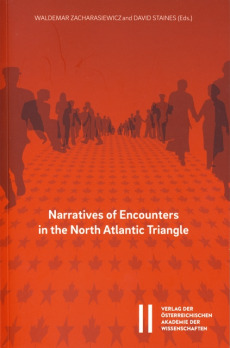Narratives of Encounters in the North Atlantic Triangle
Herausgegeben von David Staines, Herausgegeben von Waldemar Zacharasiewicz
Reihe: Sitzungsberichte der philosophisch-historischen KlasseDer Band enthält 23 Beiträge in englischer und französischer Sprache von prominenten WissenschaftlerInnen aus Europa und Nordamerika, die den dynamischen Kulturaustausch zwischen verschiedenen Ländern und Nationen des nordatlantischen Raumes untersuchen. Aus dem Blickwinkel mehrerer Disziplinen erhellen sie dabei signifikante Entwicklungen in Kunst und Literatur, in Geschichte und Gesellschaft, Medizin und Politik. Ihre Entdeckungen eröffnen fruchtbare Perspektiven auf die sich wandelnden kulturellen Potentiale und ihren Zusammenhang in der kollektiven Erfahrung diesseits und jenseits des Nordatlantiks. Das breite Spektrum der behandelten Themen reicht von der Ausbildung nordamerikanischer Ärztinnen in Europa vor und nach 1900 bis zu einsichtsvollen Darstellungen der Leistungen großer Denker und Schriftsteller im 20. Jahrhundert, mit denen Besucher aus der anderen Hemisphäre zusammentrafen. Dabei werden die Vermittlerrolle von amerikanischen Künstlern, Kritikern und Übersetzern französischer Texte (etwa von Malcolm Cowley) ebenso sichtbar, wie auch überraschende Einsichten zum Schaffen von Malern wie John La Farge oder Fabulierern wie Friedrich Armand Strubberg im 19. Jahrhundert und emigrierten Erzählerinnen wie Marguerite Anderson und Lore Segal geboten werden. Bisher wenig bekannte Beziehungen zwischen bedeutenden Persönlichkeiten aus Kanada, den USA und Europa rücken damit als Teil des North Atlantic Triangle ins Zentrum der Betrachtung.
***
In original and thought-provoking essays in English and French, the present volume brings together 23 distinguished critics and scholars from Europe and North America to probe and reveal the dynamic interplay among the nations of this triangle. From the perspectives of various academic disciplines they comment on significant developments in art and literature, history and society, medicine and politics. Their unique discoveries offer seminal ways of looking at the fluidity of cultural resources and their interconnectedness in the shared collective experiences of Europe and North America. The wide spectrum of topics treated ranges from the investigation of the professional training of North American medical women in Europe before and after 1900 to the enlightened accounts of the literary achievements of major thinkers and writers of the 20th century encountered by visitors in the other hemisphere. The mediating role of American artists, critics and translators of French texts (such as Malcolm Cowley) is revealed, and surprising revelations about the accomplishments of artists such as John La Farge or fabulators such as Friedrich Armand Strubberg in the 19th century, and for example, the work of émigré fiction writers such as Marguerite Anderson and Lore Segal are offered. Little-known relationships between important personalities in Canada, the USA and Europe thus receive full attention as part of the North Atlantic Triangle.
